

The Center for Nutrition Studies (CNS) and its authors are not foraging experts; CNS does not promote the consumption of specific wild foods in nature. This foraging series shows the abundance of food in the natural world. Please use caution when eating anything growing in nature.
Thanks to extensive research, we know that diets without leafy greens lead to a host of negative outcomes. Whether you eat a whole food, plant-based (WFPB) or even a keto or paleo diet, chances are you agree that we need to eat greens in order to maintain optimal health. When we look at Dr. Greger’s Daily Dozen, we see a recommendation for one serving of cruciferous vegetables a day and two servings of other leafy greens. Yet some people lack access to healthy fresh greens, or at least they believe they do.
What if I told you that there are trees that produce edible and palatable leaves, and that they are much more common than you think? You’d probably wonder, why doesn’t anyone know about this or talk about it? I wonder the same thing.
One of the benefits of being a plant-based forager is that you can find cups and cups of greens growing in the wild in any given season. While chickweed (Stellaria media) gets me through the winter and early spring, the three trees listed below are able to provide an abundance of food when the leaves are on the trees; all we need to do is identify, pick, wash, and eat them.
What if I told you that there are trees that produce edible and palatable leaves, and that they are much more common than you think?
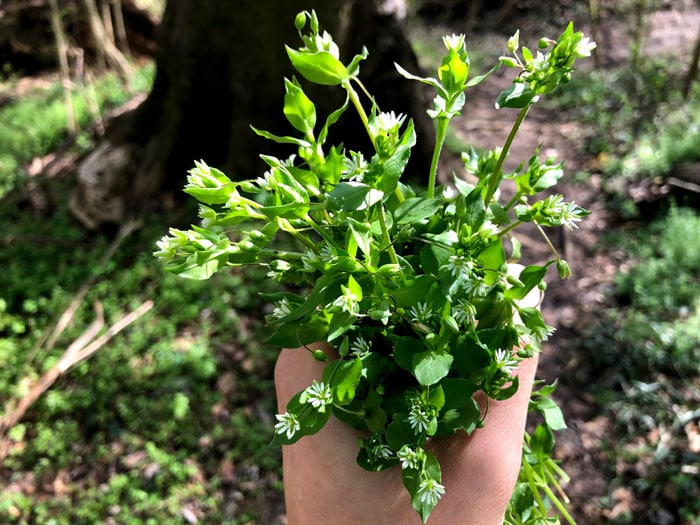
Chickweed is available all winter when trees have no leaves.
While I am of course not suggesting people defoliate an entire tree, you can safely pick lower-hanging leaves. The tree will counter this by growing taller and growing leaves beyond your reach. Those who are concerned by foragers should note that a giraffe eats about 75 lbs of food from trees per day and rarely has to ask if eating leaves off those trees is sustainable.[1] It is really the foragers who maintain the trees, while those who are ignorant of their value cut them down. See this prime example from Piedmont Park, Atlanta, Georgia. Finally, eating leaves from trees might be more sustainable than eating kale from a garden. Trees provide shelter, they grow deep roots and provide food for many different types of animals. They can live for hundreds of years and oftentimes we don’t need to tend to them. Eating more from trees might just be the most sustainable thing we can do, and it could give us nutrition we have been sorely lacking.

Here lies a 35-year-old mulberry tree cut down, likely because too much fruit was falling on the tennis court. The fruit was delicious and fed many humans and birds. Notice the fresh leaves popping up below where they girdled the tree.
Foragers classify the edibility of tree leaves and needles in different ways. Some can be used medicinally, such as using pine needles to make tea. We wouldn’t call pine needles a source of leafy greens because they are not easy to eat. Other leaves are technically edible, like spring beech leaves or spring hackberry leaves, but they aren’t all that tasty. Just because you read that a tree has edible leaves does not mean that it can be eaten at any time of year and does not mean it should be eaten raw. Not all tree leaves are edible. As always, properly identify and confirm the edibility of a leaf before attempting to consume it. Finally, be sure to check the leaves for insects prior to consumption. I found a particularly interesting sassafras leaf, and I was glad I looked inside before eating it!
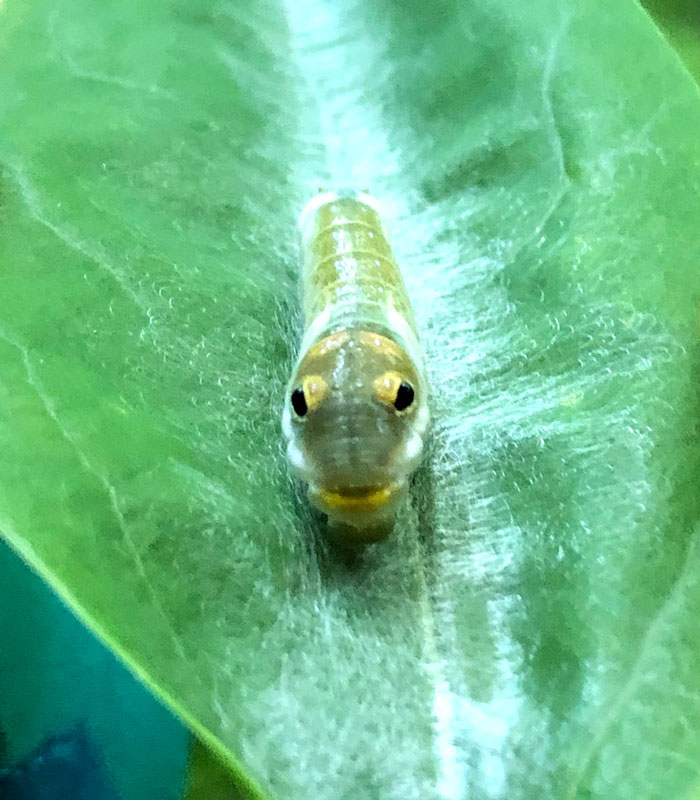
A spicebush swallowtail caterpillar (Papilio troilus) on a sassafras leaf.
The list below includes the three tree leaves that are in my opinion the tastiest in eastern North America. Two can be eaten year-round, and one is best harvested in the spring.
Edible parts: leaves, flowers, fruits
Location: North America (east of the Rocky Mountains), Europe (known as the linden tree)
Time to harvest: spring, summer, fall
Uses: in a salad, eaten raw
USDA nutrition information: nonexistent

Josh Wayne demonstrating how to forage American basswood leaves.
While we know very little about the diet of eastern indigenous peoples of the Americas, the only known indigenous group to consume these leaves was the Ojibwa. They used the tree both to eat the fresh growing leaves in the spring and to make household items like shoes, mats, baskets, and even going so far as to use the fibers to suture wounds.[2] But the part that most astounds me about this tree is the delicious leaves. While they are likely the tastiest when just appearing in the spring, they can be eaten at any point without any bitterness or off-putting flavor. Please use your judgment and be sure to look behind the leaf for any insects. Also, avoid old leaves that look sick or that might have been sprayed with any chemicals.
American basswood leaves are probably my favorite to eat because of how great they taste raw and because they can be enjoyed year-round. They can be used on a salad in place of lettuce, making them a great source of delicious raw, leafy greens. While they can be cooked, they tend to lose their flavor when heated up.
They have a slightly mucilaginous consistency. If you don’t forage for plants, you might not know the word “mucilage” or the texture associated with it, unless you’ve eaten okra. That slimy, gooey, and soothing texture is only slightly present in American basswood leaves, without being overwhelming. I would describe basswood leaves as about one-tenth as mucilaginous as sassafras leaves (discussed below). For this reason, I find it is much easier to eat a cup of basswood leaves as compared to eating a cup of sassafras leaves. Each has its perks, as I will explore below, but as a point of comparison, cruciferous vegetables and most of the vegetables we buy in stores have very low levels of mucilaginous consistency.
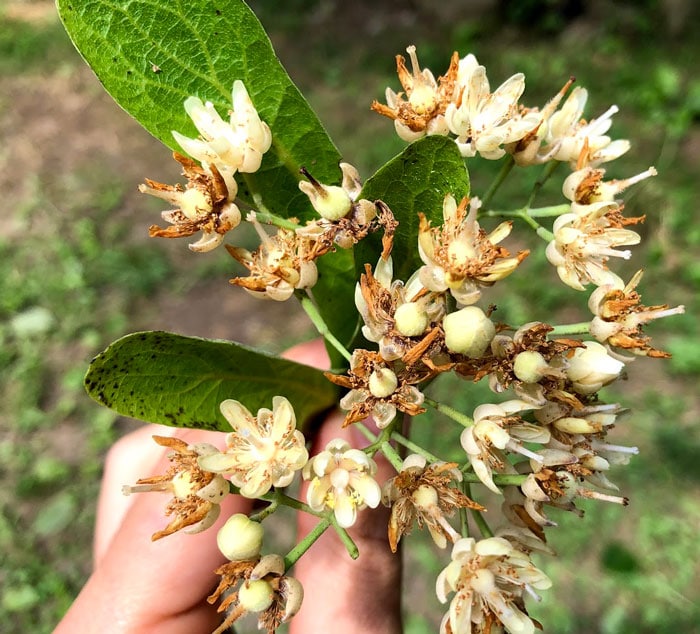
The leaves and flowers of the basswood tree are edible and also used dried in teas.
Edible parts: leaves
Location: native to Central and Eastern North America
Time to harvest: spring, summer, fall
Uses: in a salad eaten raw, dehydrated for soup thickener
USDA nutrition information: nonexistent
You might know sassafras as the plant responsible for great-tasting root beer. If you are familiar with creole cooking, you know that you can’t make Creole gumbo filé without the sassafras leaf.[3] This delicious, sweet, mucilaginous plant has a scandalous history full of reductionist science and misleading claims. You may hear that sassafras root contains a cancer-causing agent known as safrole,[4] but should we be afraid of safrole when simply consuming the leaves or the occasional root tea? Probably not.
In their report on carcinogens, the U.S. National Institutes of Health (NIH) states that, “safrole may be ingested in edible spices, including sassafras, cinnamon, nutmeg, mace, star anise, ginger, black and white pepper, and from chewing betel quid; all of these substances contain naturally occurring safrole at low levels.”[4]
We should note that of the above spices, only sassafras is native to the United States, and all others are imported and taxed, bringing in revenue and controlling the supply of this compound.
Safrole levels are not detectable in the leaves themselves, but rather in the bark and the root. The issue arises when we isolate safrole and strip away the rest of the plant and feed that compound to an animal on a regular basis against its will.[4] Indeed, rats showed increased liver cancer with safrole exposure. The methods of the study must be read to see if it applies to humans consuming leaves and the occasional root tea.
According to the study methods, “Liver cancer (hepatocellular carcinoma) was also observed in mice of both sexes administered safrole by stomach tube from 7 to 28 days of age, followed by dietary exposure for up to 82 weeks, and in infant male mice administered safrole by subcutaneous injection.”
Does this finding generalize to humans who might eat a few leaves or make tea once in a while? Doubtful.
According to the NIH, “No epidemiological studies were identified that evaluated the relationship between human cancer and exposure specifically to safrole.”
This is similar to the idea that white button mushrooms contain a carcinogen so we shouldn’t eat them raw. If this is truly an area of concern, we should see an increased risk for cancer among mushroom consumers and an increased risk of liver cancer among sassafras consumers. But, just as we do not see increased cancer rates in those consuming button mushrooms,[5] we do not see increased liver cancer rates in those living in Appalachia who have consumed this plant — both leaves and roots — for much of their lives and for generations.[4]
So why the confusion? The real reason safrole has been targeted is that it can be used in the synthesis of the drug known as MDMA, or ecstasy. Because of this use, it is not legal to sell highly processed sassafras oil, in the event that it may be used as a dangerous and illegal drug.[6] You also cannot sell sassafras bark or tea unless the safrole has first been removed and discarded.[7] For this reason, true root beer can no longer be made from sassafras root.
My recommendation, for now, is to stick with the leaves because you can legally harvest them. It doesn’t require digging up the plant and killing it, and you can add dried leaves to soups like gumbo filé to be used as a thickener. You can also purchase sassafras root with the safrole removed. The leaves do not contain safrole[8], and there is no evidence to suggest that consuming sassafras leaves on a daily basis will lead to any ill effects, though. On the contrary, they taste delicious and have been one of my favorite leaves to consume due to their great flavor.
Edible parts: leaves
Location: east of the Rocky Mountains in the United States (red mulberry); South Asia, Europe, Southern Africa, South America (white mulberry)
Time to harvest: spring, summer, fall
Uses: in a salad eaten raw, dehydrated for soup thickener
USDA nutrition information: only for mulberries https://fdc.nal.usda.gov/fdc-app.html#/food-details/169913/nutrients
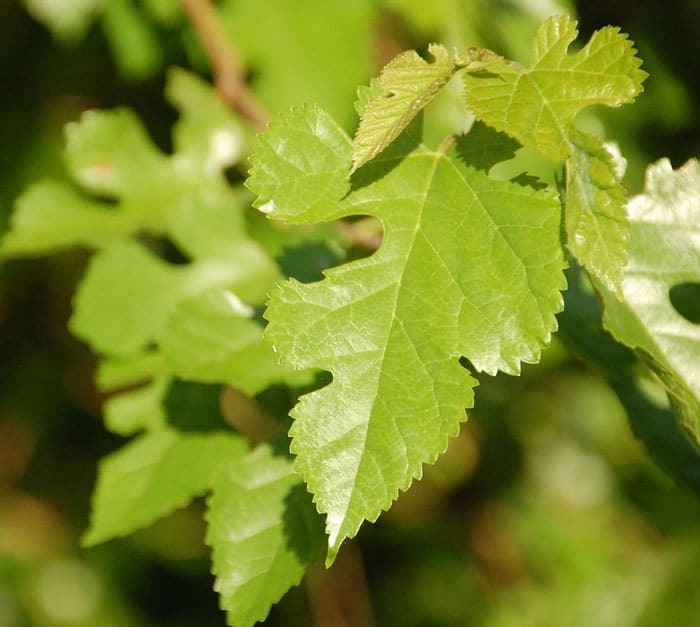
Young mulberry leaf ready to be picked.
Finally, we can get back to some less controversial plants! The mulberry tree has an interesting history in the United States. There is a native mulberry called a red mulberry, or Morus rubra. This mulberry tree might not produce the most fruit compared with the Asian varieties, but it does produce larger fruit and very large leaves. These leaves are edible when picked in the spring and cooked, and they can be used to make tea from dehydrated and chopped leaves. Many people spend a decent amount of money on mulberry leaf tea, when chances are the tree is growing right in their own backyard! Of course the berries are absolutely delicious, but those recipes are for another article!
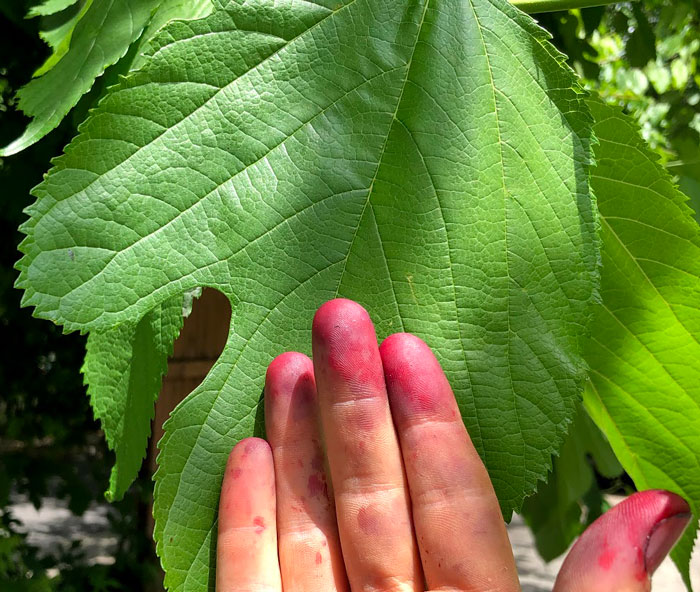
The large leaves of native red mulberry and dark coloring from the vibrant and delicious berries. If the berries are on the trees, focus on the berries.
The white mulberry and Asian mulberry varieties were introduced to North America in an attempt to bring silk farming to the United States. Silk farming failed, but the Asian mulberries remained and have interbred with the native trees, forming dense fruiting mulberry trees. The leaves of all mulberries can be consumed when properly prepared. I’ve eaten them raw, but they don’t taste nearly as good as the other two leaves mentioned in this article. Fresh mulberry leaves can be cooked and consumed in a salad, or they can be dehydrated and used for teas or soups. You can also use them to make dolmas instead of grape leaves. One of the best perks to knowing how to identify a mulberry tree is getting to enjoy the mulberries that come in late spring and early summer.
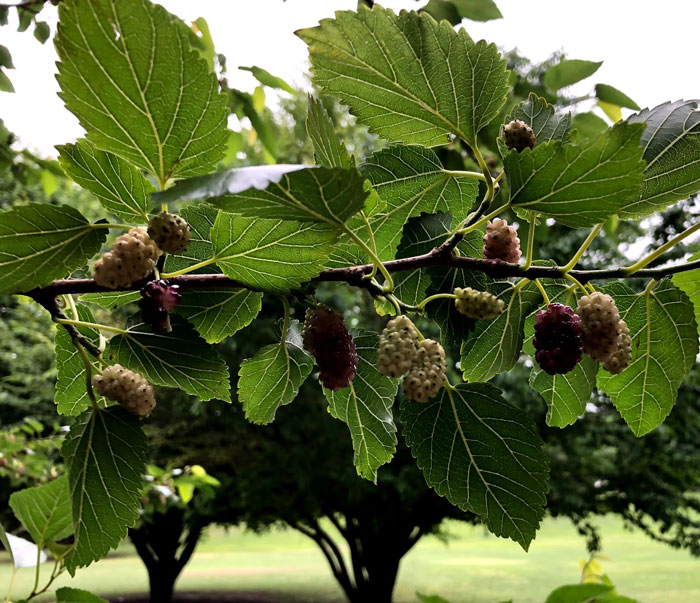
White and purple mulberry variety in Atlanta, Georgia.
While the paper mulberry, Broussonetia papyrifera, is a different genus altogether, it can also be prepared similarly to red or white mulberry leaves, by cooking young leaves or drying and powdering.
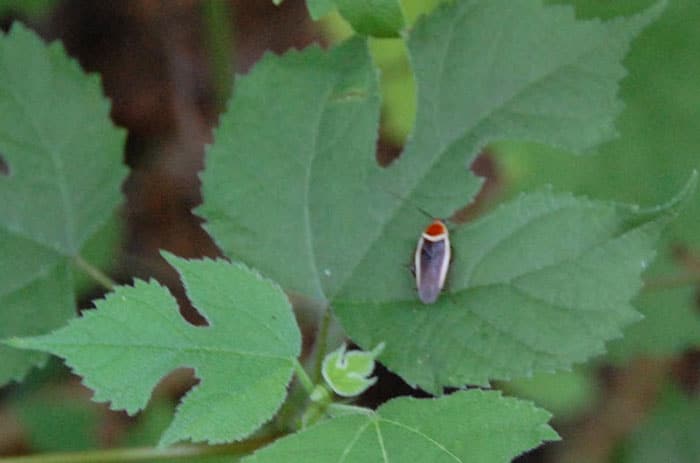
Firefly on a paper mulberry tree.
As always when foraging, be sure to identify the plant or mushroom in question before eating it. If you don’t know how to come to a sound identification, read my article 5 Steps to Start Foraging. There are great tips in the article that will point you in the right direction to get you started on your foraging journey.
Copyright 2025 Center for Nutrition Studies. All rights reserved.